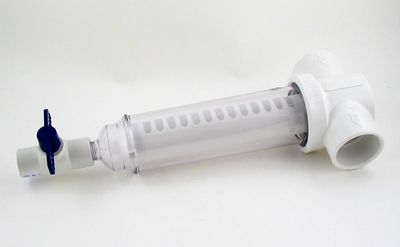How Spin Down Sediment Filters Work

The "Spin Down" filter pictured above can handle high flow rates and very dirty water. Its function is to remove larger sediment (such as sand) from the water stream.
The unit is installed into a horizontal water line with the black-handled ball valve pointed down. A hose can be easily attached to the bottom of the valve to facilitate drainage.
As sediment-filled water enters the filter it is swirled rapidly in the clear chamber around the center core, which is a filter screen. Heavier particles are spun to the outside wall and drop out of the water stream. Water flows through the filter screen and exits the out port of the filter.
When sediment has collected in the filter, it can be easily blown out by opening the ball valve. Full line pressure will purge the filter of collected sediment and rinse the screen.
The replaceable screens have a very long life span, as water filters go. Screens are measured by mesh size (the number of holes per square inch in the screen material). The larger the mesh number, the tighter the screen and the smaller the particles it will catch. For example, a 250 mesh screen catches smaller particles but is easier to clog as compared with a 100 mesh screen.
Filter screens are replaceable in most units of this type. Measurement can be expressed in microns, but are more usually referred to by mesh.
Common mesh sizes for spin down filters with micron equivalents are
100 mesh equals about 149 microns.
400 mesh equals 37 microns.
More information about spin down filters.